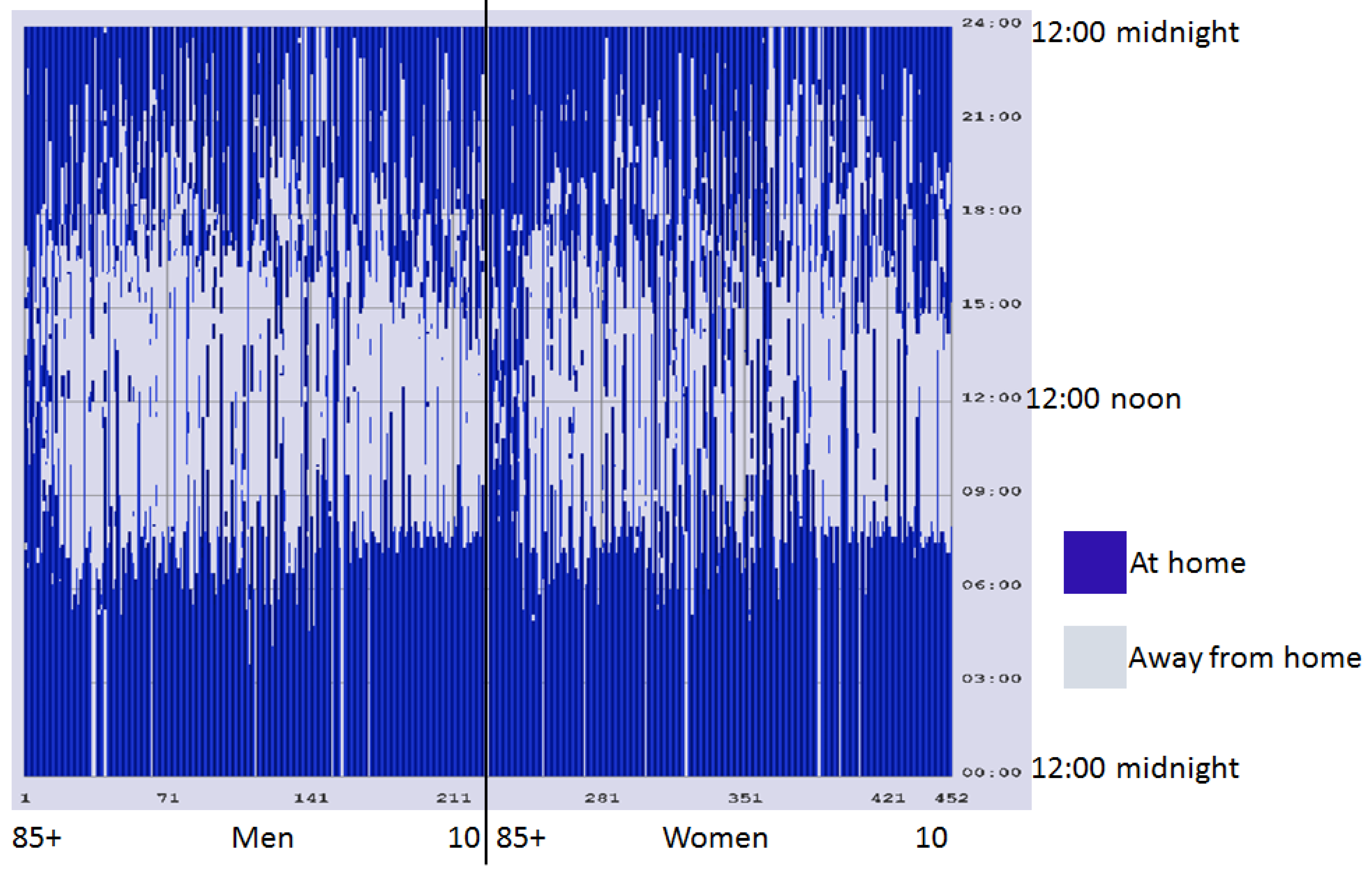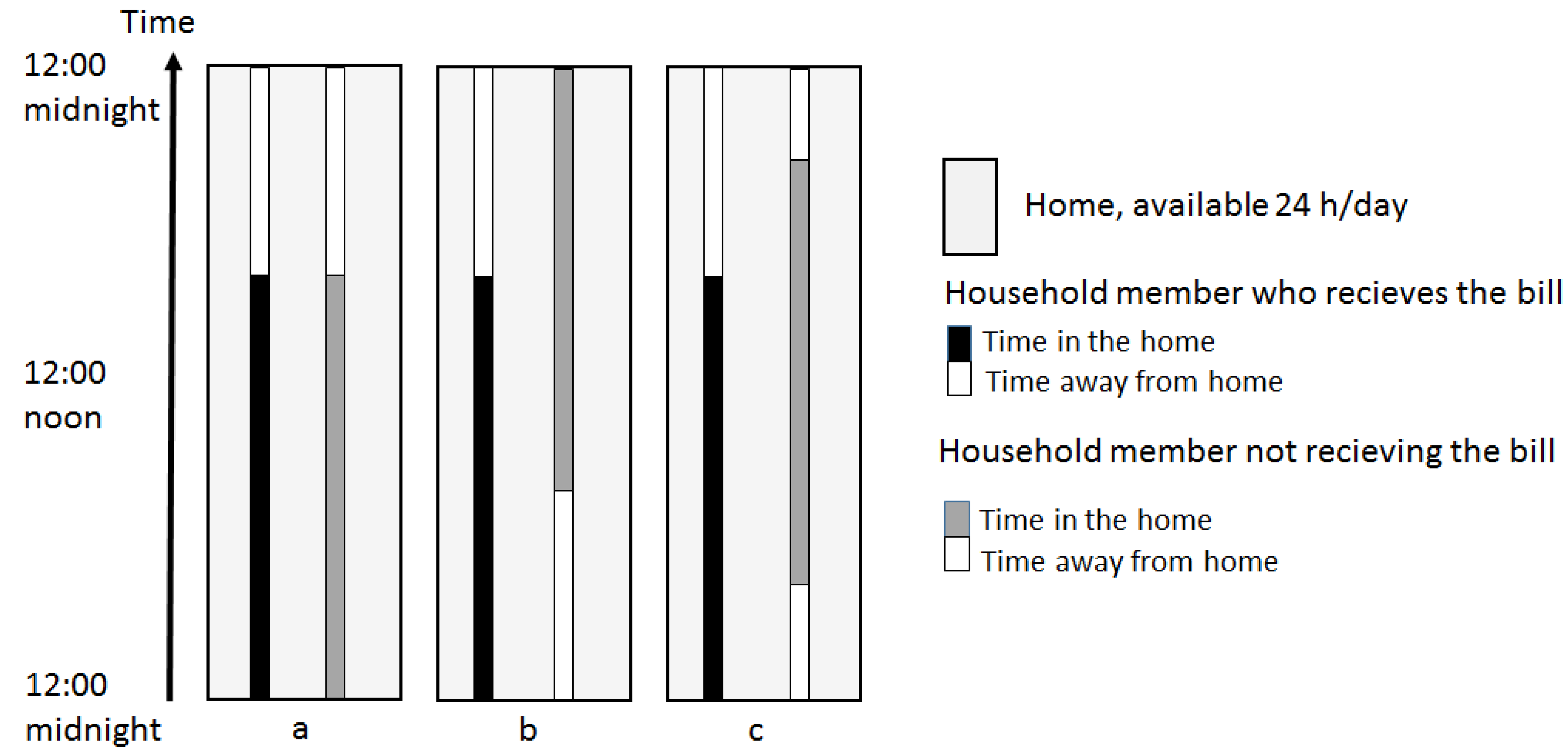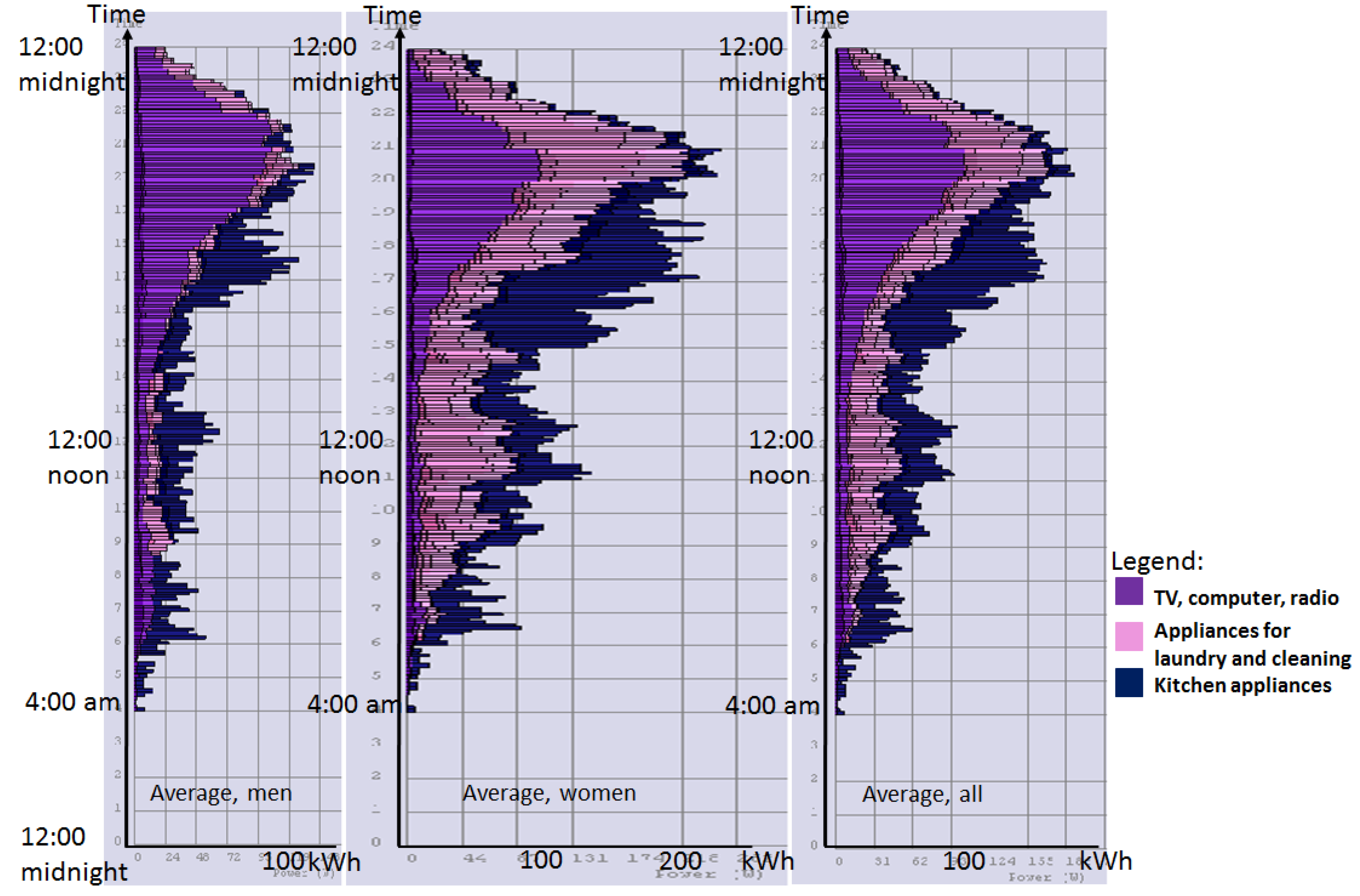Who Is Behaving? Consequences for Energy Policy of Concept Confusion
Abstract
:1. Introduction
2. Material and Methods
3. Overview of Earlier Research on Household-Targeted Energy Policy
Household or Household’s Members as Targets of Information?
4. Basic Information Concerning Energy Use in Sweden
5. Results and Discussion
5.1. Individual or Household: Relevance to Scheduled Control Indoor Temperature


5.2. Individual or Household: Division of Labor in Household Projects

5.3. Gender Aspects of Policies Promoting Household Sector Energy Conservation


6. Conclusions
Acknowledgments
Author Contributions
Conflicts of Interest
References and Notes
- Palm, J. The public-private divide in household behavior: How far into home can energy guidance reach? Energy Policy 2010, 38, 2858–2864. [Google Scholar] [CrossRef]
- Gyberg, P.; Palm, J. Influencing households’ energy behaviour—How is this done and on what premises? Energy Policy 2009, 37, 2807–2813. [Google Scholar] [CrossRef]
- Sernhed, K. Effekten Av Effekten. Elanvändning Och Laststyrning i Elvärmda Småhus Ur Kund-och Företagsperspektiv. Fallstudier. In Avdelningen för Energihushållning, Institutionen för Värme-och kraftteknik, Lunds universitet; Lund University: Lund, Sweden, 2004. (In Swedish) [Google Scholar]
- Statistic Sweden. Statistikdatabasen. Available online: http://www.ssd.scb.se/databaser/makro/MainTable.asp?yp=tansss&xu=C9233001&omradekod=BE&omradetext=Befolkning&lang=1&langdb=1 (accessed on 8 January 2014).
- Isaksson, C. Uthålligt Lärande Om Värmen? Domesticering Av Energiteknik i Passivhus. Ph.D. Thesis, Linköping University, Linköping, Sweden, 1 October 2009. [Google Scholar]
- Palm, J.; Darby, S.J. The meanings of practices for energy consumption—A comparison of homes and workplaces. Sci. Technol. Stud. 2014, 27, 72–92. [Google Scholar]
- Isaksson, C.; Ellegård, K. Dividing or Sharing? A Time-geographical Examination of Eating, Labor, and Energy Consumption in Sweden. Energy Res. Social Sci. 2015, in press. [Google Scholar]
- Hägerstrand, T.; Ellegård, K.; Svedin, U.; Lenntorp, B. Tillvaroväven; Forskningsrådet Formas: Stockholm, Sweden, 2009. (In Swedish) [Google Scholar]
- Hägerstrand, T. What about people in regional science? Pap. Reg. Sci. 1970, 24, 7–24. [Google Scholar] [CrossRef]
- Ellegård, K. A time-geographical approach to the study of everyday life of individuals—A challenge of complexity. GeoJournal 1999, 48, 167–175. [Google Scholar] [CrossRef]
- Lenntorp, B. Paths in space-time environments: A time-geographic study of movement possibilities of individuals. Environ. Plan. A 1977, 9, 961–972. [Google Scholar]
- Statistic Sweden. The work reported in this paper has been carried out by Statistics Sweden as a part of, and with financial support by research and development work in Statistics- sup.Com 95.
- Ellegård, K.; Vrotsou, K. Capturing Patterns of Everyday Life: Presentation of the Visualization Method Visual-timepacts. In Proceedings of the International Association for Time-Use Research Conference, Copenhagen, Denmark, 16 August 2006.
- Widén, J. System Studies and Simulations of Distributed Photovoltaics in Sweden. Available online: http://www.citeulike.org/user/pbett/article/12788325 (accessed on 22 July 2015).
- Widén, J.; Molin, A.; Ellegård, K. Models of domestic occupancy, activities and energy use based on time-use data: Deterministic and stochastic approaches with application to various building-related simulations. J. Build. Perform. Simul. 2012, 5, 27–44. [Google Scholar] [CrossRef]
- Widén, J.; Karlsson, K. The Influence of Swedish Households’ Everyday Activities and Electricity-Use Patterns on the Utilization of Small-Scale Photovoltaic Systems. In Proceedings of the European Council for an Energy Efficient Economy, La Colle-sur-Loup, France, 1–6 June 2009.
- Bemelmans-Videc, M.-L.; Rist, R.C.; Vedung, E. Carrots, Sticks and Sermons: Policy Instruments and Their Evaluation; Transaction: New Brunswick, NJ, USA, 2003. [Google Scholar]
- Lindén, A.L.; Carlsson-Kanyama, A.; Eriksson, B. Efficient and inefficient aspects of residential energy behaviour: What are the policy instruments for change? Energy Policy 2006, 34, 1918–1927. [Google Scholar] [CrossRef]
- Vedung, E. Konsten Att Utvärdera Nätverk; Forsknings-och utvecklingscentralen för social-och hälsovården: Helsingfors, Finland, 2006. (In Swedish) [Google Scholar]
- Näringsdepartmentet. Samverkan för en Trygg, Effektiv Och Miljövänlig Energiförsörjning; Näringsdep., Regeringskansliet: Stockholm, Sweden, 2002. (In Swedish) [Google Scholar]
- Commission of the European Communities. Proposal for a Directive of the European Parliament of the Council on Energy End-use Efficiency and Energy Services. Available online: http://eur-lex.europa.eu/legal-content/EN/TXT/?uri=URISERV:l27057 (accessed on 6 January 2014).
- Henryson, J.; Håkansson, T.; Pyrko, J. Energy efficiency in buildings through information—Swedish perspective. Energy Policy 2000, 28, 169–180. [Google Scholar] [CrossRef]
- Gardner, G.T.; Stern, P.C. The short list: The most effective actions U.S. Households can take to curb climate change. Environment 2008, 50, 12–24. [Google Scholar] [CrossRef]
- Laitner, J.A.; Ehrhardt-Martinez, K.; McKinney, V. Examining the Scale of the Behaviour Energy Efficiency Continuum. In Proceedings of the European Council for an Energy Efficient Economy, La Colle sur Loup, France, 1–6 June 2009.
- Berkhout, P.H.G.; Muskens, J.C.; Velthuijsen, J.W. Defining the rebound effect. Energy Policy 2000, 28, 425–432. [Google Scholar] [CrossRef]
- Sorrell, S. Reducing energy demand: A review of issues, challenges and approaches. Renew. Sustain. Energy Rev. 2015, 47, 74–82. [Google Scholar] [CrossRef]
- Sorrell, S.; Dimitropoulos, J.; Sommerville, M. Empirical estimates of the direct rebound effect: A review. Energy Policy 2009, 37, 1356–1371. [Google Scholar] [CrossRef]
- Vedung, E. Informativa Styrmedel; Uppsala University: Uppsala, Sweden, 1995. [Google Scholar]
- Shove, E.; Lutzenhiser, L.; Guy, S.; Hackett, B.; Wilhite, H. Energy and social systems. Hum. Choice Clim. Chang. 1998, 2, 291–325. [Google Scholar]
- Benders, R.M.J.; Kok, R.; Moll, H.C.; Wiersma, G.; Noorman, K.J. New approaches for household energy conservation-in search of personal household energy budgets and energy reduction options. Energy Policy 2006, 34, 3612–3622. [Google Scholar] [CrossRef]
- Steg, L. Promoting household energy conservation. Energy Policy 2008, 36, 4449–4453. [Google Scholar] [CrossRef]
- van der Werff, E.; Steg, L. One model to predict them all: Predicting energy behaviours with the norm activation model. Energy Res. Soc. Sci. 2015, 6, 8–14. [Google Scholar] [CrossRef]
- Abrahamse, W.; Steg, L.; Vlek, C.; Rothengatter, T. The effect of tailored information, goal setting, and tailored feedback on household energy use, energy-related behaviors, and behavioral antecedents. J. Environ. Psychol. 2007, 27, 265–276. [Google Scholar] [CrossRef]
- Lee, B.-K.; Lee, W.-N. The effect of information overload on consumer choice quality in an on-line environment. Psychol. Mark. 2004, 21, 159–183. [Google Scholar] [CrossRef]
- Malhotra, N.K. Reflections on the information overload paradigm in consumer decision making. J. Consum. Res. 1984, 10, 436–440. [Google Scholar] [CrossRef]
- Palm, J.; Tengvard, M. Motives for and barriers to household adoption of small-scale production of electricity: Examples from sweden. Sustain. Sci. Pract. Policy 2011, 7, 6–15. [Google Scholar]
- Murray, A.G.; Mills, B.F. Read the label! Energy star appliance label awareness and uptake among U.S. consumers. Energy Econ. 2011, 33, 1103–1110. [Google Scholar] [CrossRef]
- Palm, J.; Ellegård, K. Visualizing energy consumption activities as a tool for developing effective policy. Int. J. Consum. Stud. 2011, 35, 171–179. [Google Scholar] [CrossRef]
- Ellegård, K.; Palm, J. Visualizing energy consumption activities as a tool for making everyday life more sustainable. Appl. Energy 2011, 88, 1920–1926. [Google Scholar] [CrossRef]
- Christie, L.; Donn, M.; Walton, D. The ‘apparent disconnect’ towards the adoption of energy-efficient technologies. Build. Res. Inf. 2011, 39, 450–458. [Google Scholar] [CrossRef]
- Nair, G.; Gustavsson, L.; Mahapatra, K. Factors influencing energy efficiency investments in existing swedish residential buildings. Energy Policy 2010, 38, 2956–2963. [Google Scholar] [CrossRef]
- Gadenne, D.; Sharma, B.; Kerr, D.; Smith, T. The influence of consumers’ environmental beliefs and attitudes on energy saving behaviours. Energy Policy 2011, 39, 7684–7694. [Google Scholar] [CrossRef]
- Garabuau-Moussaoui, I. Energy-related logics of action throughout the ages in france: Historical milestones, stages of life and intergenerational transmissions. Energy Effic. 2011, 4, 493–509. [Google Scholar]
- Kelly, G. Sustainability at home: Policy measures for energy-efficient appliances. Renew. Sustain. Energy Rev. 2012, 16, 6851–6860. [Google Scholar] [CrossRef]
- Shwom, R.; Lorenzen, J.A. Changing household consumption to address climate change: Social scientific insights and challenges. Wiley Interdiscip. Rev. Clim. Chang. 2012, 3, 379–395. [Google Scholar] [CrossRef]
- Hargreavesn, T.; Nye, M.; Burgess, J. Making energy visible: A qualitative field study of how householders interact with feedback from smart energy monitors. Energy Policy 2010, 38, 6111–6119. [Google Scholar] [CrossRef]
- Maréchal, K. Not irrational but habitual: The importance of “behavioural lock-in” in energy consumption. Ecol. Econ. 2010, 69, 1104–1114. [Google Scholar] [CrossRef]
- Kua, H.W.; Wong, S.E. Lessons for integrated household energy conservation policies from an intervention study in singapore. Energy Policy 2012, 47, 49–56. [Google Scholar] [CrossRef]
- Räty, R.; Carlsson-Kanyama, A. Energy consumption by gender in some european countries. Energy Policy 2010, 38, 646–649. [Google Scholar] [CrossRef]
- Røpke, I.; Haunstrup Christensen, T.; Ole Jensen, J. Information and communication technologies—A new round of household electrification. Energy Policy 2010, 38, 1764–1773. [Google Scholar] [CrossRef]
- Zhang, T.; Siebers, P.O.; Aickelin, U. A three-dimensional model of residential energy consumer archetypes for local energy policy design in the UK. Energy Policy 2012, 47, 102–110. [Google Scholar] [CrossRef]
- Swedish Energy Agency. Energiläget i Siffror 2015; Swedish Energy Agency: Eskilstuna, Sweden, 2015. (In Swedish)
- Statens Offentliga Utredningar. Vägen Till Ett Energieffektivare Sverige: Slutbetänkande; Fritze: Stockholm, Sweden, 2008. (In Swedish) [Google Scholar]
- Bladh, M. Hushållens Elförbrukning: Utvecklingen Totalt Och i Detalj 1980–2000; Tema University: Linköping, Sweden, 2005. (In Swedish) [Google Scholar]
- Statistic Sweden. Statistisk årsbok för sverige. Årg. 95 (2009); Statistiska centralbyrån: Stockholm, Sweden, 2008. (In Swedish)
- Ellegård, K. Lockropen ljuder: Kom.Hem. In Den gränslösa medborgaren: En antologi om en möjlig dialog; Agora: Stockholm, Sweden, 2002. (In Swedish) [Google Scholar]
- Ellegård, K.; Cooper, M. Complexity in daily life—A 3d-visualization showing activity patterns in their contexts. Electron. Int. J. Time Use Res. 2004, 1, 37–59. [Google Scholar] [CrossRef]
- Vrotsou, K.; Ellegård, K.; Cooper, M. Exploring time diaries using semi-automated activity pattern extraction. Electron. Int. J. Time Use Res. 2009, 6, 1–25. [Google Scholar] [CrossRef]
- Isaksson, C. Uthålligt Lärande Om Värmen? Domesticering Av Energiteknik i Passivhus. Available online: http://www.diva-portal.org/smash/record.jsf?pid=diva2%3A278013&dswid=5592 (accessed on 22 July 2015).
- Karresand, H. Apparater, Aktiviteter Och Aktörer: Lågenergiboende Som Resurs Och Restriktion för Energiordningar. Available online: http://liu.diva-portal.org/smash/get/diva2:748731/FULLTEXT02.pdf (accessed on 22 July 2015).
- Eurostat (Statistical Office of the European Communities). How Europeans Spend Their Time: Everyday Life of Women and Men; Data 1998–2002. Available online: http://www.unece.org/fileadmin/DAM/stats/gender/publications/Multi-Country/EUROSTAT/HowEuropeansSpendTheirTime.pdf (accessed on 22 July 2015).
© 2015 by the authors; licensee MDPI, Basel, Switzerland. This article is an open access article distributed under the terms and conditions of the Creative Commons Attribution license (http://creativecommons.org/licenses/by/4.0/).
Share and Cite
Ellegård, K.; Palm, J. Who Is Behaving? Consequences for Energy Policy of Concept Confusion. Energies 2015, 8, 7618-7637. https://doi.org/10.3390/en8087618
Ellegård K, Palm J. Who Is Behaving? Consequences for Energy Policy of Concept Confusion. Energies. 2015; 8(8):7618-7637. https://doi.org/10.3390/en8087618
Chicago/Turabian StyleEllegård, Kajsa, and Jenny Palm. 2015. "Who Is Behaving? Consequences for Energy Policy of Concept Confusion" Energies 8, no. 8: 7618-7637. https://doi.org/10.3390/en8087618





